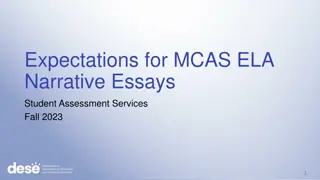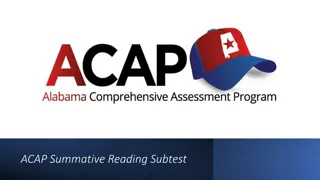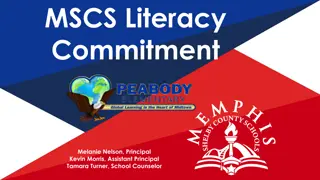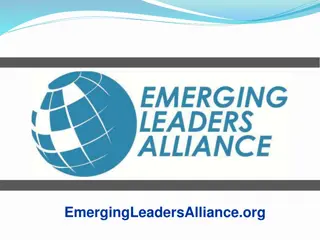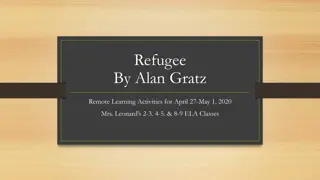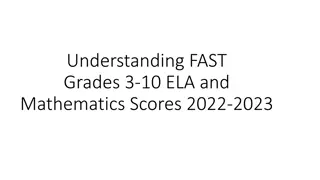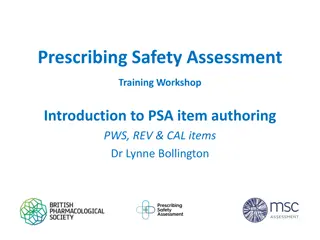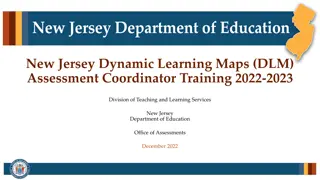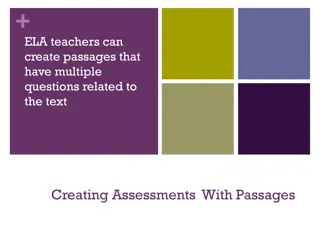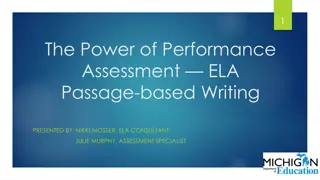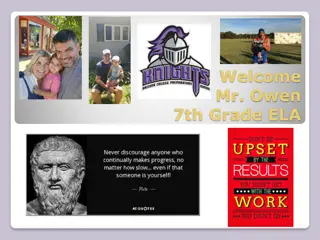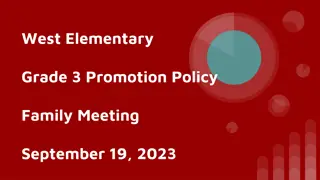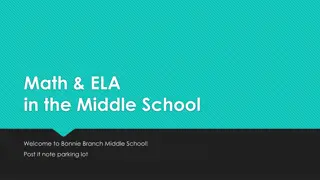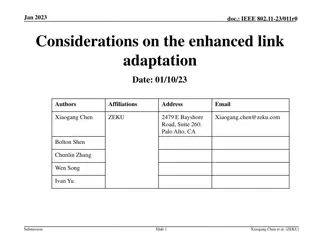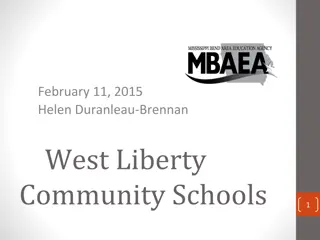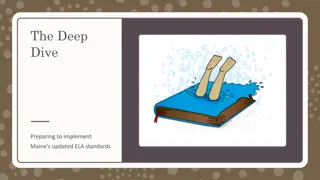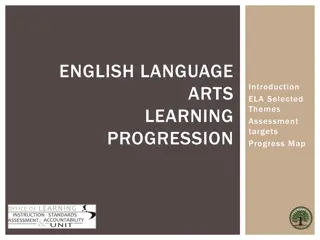ELA ITEM TYPES
This content provides an overview of the National Action Plan for Health Security (NAPHS), including processes, tools, and key components such as the coordination team, epidemic preparedness, IHR, and capacity building stages. It highlights the importance of NAPHS in maintaining global health security and outlines strategic and operational plans for effective response to health emergencies.
Download Presentation

Please find below an Image/Link to download the presentation.
The content on the website is provided AS IS for your information and personal use only. It may not be sold, licensed, or shared on other websites without obtaining consent from the author. Download presentation by click this link. If you encounter any issues during the download, it is possible that the publisher has removed the file from their server.
E N D
Presentation Transcript
ELA ITEM TYPES Item types Assessing item quality
4 BUILDING BLOCKS Learning Progression Item Design Assessment Quality Outcomes/ Scoring
ITEM TYPES Classification of item types: Objective Performance based Item types (SBAC, 2012, pp. 27 32): Selected response (SR) Constructed response (CR) Extended response (ER) Technology-enhanced item (TE) Performance task (PT)
CLASSIFICATIONS OF ITEMS Objective Subjective/ Performance based Selected Response : True/False Multiple choice Constructed (restricted ) response: Short answer Technology-enhanced Extended response: Essay Performance task: Group/individual Project/portfolio Class participation Peer assessment
SELECTED RESPONSE (SR) Contain a set of options from which to select correct response(s) Checklist: Does the item assess an important aspect of the standard? Does the stem ask a direct question or set of specific problem? Is the item based on a paraphrase rather than words lifted directly from a textbook? Are the vocabulary and sentence structure at a relatively low and nontechnical level?
SELECTED RESPONSE (SR) Checklist (continued): Is each alternative (stem) plausible so that a student who lacks of knowledge of the correct answer cannot view it as absurd or silly? If possible, is every incorrect alternatives based on a common student error or misconception? Is the correct answer of the item independent of the correct answers of the other items? Is there only one correct or best answer to the item?
SR: MULTIPLE CHOICE Advantages Disadvantages Dos and Don ts Ease and objectivity in scoring Can assess a number of learning targets Focus on reading and thinking Less chance of randomly guessing answers than in T/F items Incorrect response(s) may indicate misconceptions May only assess lower- level thinking, if poorly written Discourage students from expressing own solutions Limited sampling of content Difficult to construct distinct and meaningful incorrect responses Write the question or task clearly by focusing it on specific learning target(s) Write the correct answer along with concise and unambiguous incorrect responses Write plausible incorrect responses (i.e. not obviously wrong responses) Avoid using all/none of the above or a combination of correct answers as alternatives Avoid using negative or double negative statements
EXAMPLE 1: POOR AND BETTER Read this sentence from the article: Rainfall data from ancient cypress trees shows that the region's worst drought in 800 years peaked in 1587, the year the 120 men, women and children of the Roanoke colony were last seen by Europeans. What does peaked mean in this sentence? Poor: A. was sharp B. was at its height C. was wet D. was dry Better: A. was sharp B. was at its height C. was mountainous D. was rising Wrong answers are too obviously wrong Distractors are more plausible.
EXAMPLE 2: POOR AND BETTER Poor Which of the following is least dissimilar in meaning to concur ? Double negatives A. misalign B. assent C. withdraw D. sanitize Better Which of the following is most similar in meaning to concur ? A. misalign B. assent C. withdraw D. sanitize
CONSTRUCTED RESPONSE (CR) Require student to generate a response in one or more words Checklist: Does the item assess an important aspect of the standard? Is the item based on a paraphrase rather than sentence copied from a book? Is the item worded clearly so that the correct answer is a brief phrase, single word of single number?
CONSTRUCTED RESPONSE (CR) Checklist, continued: Is the blank or answer space toward the end of the sentence? Are there only one or two blanks? If the item is in the completion format, is the omitted word an important word rather than a trivial word? If appropriate, does the item (or the directions) inform the appropriate degree of detail, specificity, precision, or units that the answer should have? Does the item avoid grammatical (and other irrelevant) clues to the correct answer?
CR: SHORT ANSWER Advantages Easy construction of question Disadvantages May not be able to anticipate all possible answers Dos and Don ts Carefully choose correct wordings of question so that the required answer is both brief and specific Ease and objectivity in scoring May only assess lower-level thinking Do not form a question based on a direct copy of statements from textbook Harder to measure complex learning outcomes Less chance given to students in guessing the answer Give enough indication of type of answer wanted
CR : RESTRICTED RESPONSE ESSAY Advantages Disadvantages Dos and Don ts Easy construction of question Can measure complex learning skills Assess and improve high- order thinking Can positively influence students studying strategies Time- consuming and error in scoring Construct questions that can assess behavior specified in the learning outcomes Phrase the question so that the student s task is clearly indicated Indicate an approximate time limit for each question Avoid the use of optional question Limited sampling of content
EXAMPLE: POOR AND BETTER The Greek mythical hero Hercules was given twelve great tasks to complete as penance. One such task was the cleaning of the enormous royal Aegean stables in a single day, which Hercules was able to complete in part due to his great strength. Poor Explain herculean task Unclear wording Better Better The modern phrase herculean task comes from this myth explain, in everyday language, what it means and how it is related to the myth.
EXTENDED RESPONSE (ER) Require student to provide more elaborate answers and explanations of reasoning Checklist: Does the item assess an important aspect of one or a set of standards? How does the item tap into the level of depth of knowledge as defined by the taxonomy? Does the item require students to apply their knowledge to a new or novel situation?
EXTENDED RESPONSE (ER) Checklist, cont d: Does the item define the tasks with specific directions and focus? Is the prompt worded in a way that students can interpret the intended task? Does the prompt give clear information on the length of answers/writing, purpose, time needed, and basis on which the answers will be scored? If the item is on a controversial matter, does the prompt make it clear that the assessment will be based on the logic and evidence supporting the argument, rather than on the actual position taken?
ER: EXTENDED RESPONSE ESSAY Advantages Disadvantages Dos and Don ts Easy construction of question Can measure complex learning skills Assess and promote high-order thinking Can positively influence students studying strategies Time-consuming and error in scoring Construct questions that can assess behavior specified in the learning outcomes Phrase the question so that the student s task is clearly indicated Indicate an approximate time /word limit for each question Avoid the use of optional question Unlimited sampling of content Possible multiple answers unreliable
EXAMPLE: POOR Sisyphus was the son of King Aeolus of Thessaly, and was avaricious, deceitful, and murderous. In life, Sisyphus believed himself more clever than the gods. In some versions of the myth, after his death he was sent to Tartarus (a deep abyss of torment, as far below Hades as the earth is below the heavens). Once there, Sisyphus deceived Thanatos, the personification of death, into chaining himself and escaped. While Thanatos was trapped in Tartarus, no human could die. As punishment for his trickery and hubris, Sisyphus was made to endlessly roll a huge boulder up a steep hill. Each time Sisyphus neared the top of the hill, the boulder would roll back to the bottom, and he would have to begin again. In plain words, what is a Sisyphean task? How is it different from a herculean task? In common usage, what aspect of the story of Sisyphus is most important for how the term sisyphean task is used commonly today? Vocabulary is unnecessarily complicated
SAME EXAMPLE: BETTER Sisyphus was the son of King Aeolus of Thessaly. He was greedy, dishonest, and murderous. He thought he was more clever than the gods. After his death he was sent to Tartarus (a deep abyss of torment, worse than Hades). Once there, Sisyphus deceived Thanatos, the personification of death, into chaining himself, and escaped. As punishment for his trickery and arrogance, Sisyphus was forced to roll a huge boulder up a steep hill, forever. Each time Sisyphus neared the top of the hill, the boulder would roll back to the bottom, and he would have to begin again. Based on this story, what does it mean when something is described as a sisyphean task? How is it different from a herculean task? What aspect of the story of Sisyphus is most important for how the term sisyphean task is used today?
PERFORMANCE TASK (PT) Require students to do an activity to integrate their knowledge and skills across multiple content standards Must use clearly defined assessment criteria to evaluate how well a student has achieved the expected standards Checklist: Does the item assess an important aspect of one or a set of standards? Does the item require students to use curriculum- specified thinking process?
PERFORMANCE TASK (PT) Checklist, cont d: Is the item feasible to be done within the allocated time? Does the item define the tasks with clear directions and focus? Is the prompt worded in a way that students can interpret the intended task? Does the prompt give clear information on the expected product? Does the item allow for multiple points of view and interpretations, as intended?
EXAMPLE ITEM Which is a better material for packing fragile items to mail them, styrofoam packing peanuts, cornstarch foam packing peanuts, or crumpled paper? Which is cheaper, which is more effective, which is better for the environment? To answer these questions, follow these steps 1. Find three different sources of information about the different packing materials (can be books, newspapers, or websites). 2. Read the information carefully, and find the evidence that the authors give. Based on this information, decide which packing material you think is better. 3. Write a paragraph summarizing your position. Be sure to explain the evidence for your position, as well as any evidence against your position. Explain in detail why you think your position is better 4. Provide a bibliography of the information sources you used
PT: PROJECT/PORTFOLIO Advantages Disadvantages Dos and Don ts Demonstrate student s best work Time-consuming and error in scoring Use and hand out a scoring rubric or performance criteria to students well in advance Assess educational growth of each student Demonstrate evidence of subject-master mastery Obtain more than one rater/marker, if possible
PT: PEER ASSESSMENT Advantages Disadvantages Dos and Don ts Error in scoring Assess students real capacity in day-to-day basis Improve student engagement Use and hand out a scoring rubric or performance criteria to students well in advance Obtain more than one rater/marker, if possible Enhance academic self- belief and motivation in learning
TECHNOLOGY-ENHANCED (TE) Require student to use a technological tool to provide answer May not be feasible for day-to-day classroom assessment Item types can be of selected response or constructed response with short or brief answers
ASSESSING ITEM QUALITY Blueprint/LP/content review Alignment between standards and proposed items Predicted item difficulty versus actual difficulty Item panel Validity evidence
ITEM BLUEPRINT For each item given, teacher should be able to: explain its relationship to the framework, justify that it is appropriately expressed for the students, generate the sort of information as intended, and ensure that the sorts of responses it elicits can be scored using the scoring guide. Sample test blueprint Standards Standards Item/ Item/ Task Task Standard 1 Standard 1 Standard 2 Standard 2 Standard 3 Standard 3 Item 1 v Item 2 v v Item 3 v
ITEM PANEL Definition Judgment or review of the quality of items by same-subject teachers or subject-matter expert(s) Activities Check if the item has measured the intended learning/assessment target (standard) at appropriate level of difficulty and depth of knowledge Review the proposed item location along the LP map
VALIDITY EVIDENCE Think-aloud cognitive interviews (with example) Ask students to verbally identify their thinking process while doing the item Evaluate if students understanding of the item are as expected Exit interview Collect students opinion about the set of items Typical questions: Which item do you find it the least difficult? Why? Which item do you find it the most difficult? Why? Can you give a constructive feedback on how to improve the test? These questions may also be posed at the end of every test/learning session (change item into topic )
BIBLIOGRAPHY Nitko, A. J., & Brookhart, S. (2007). Educational assessment of students. Upper Saddle River, NJ: Pearson Education, Inc. McMillan, J. H. (2007). Classroom assessment. Principles and practice for effective standard-based instruction (4th ed.). Boston: Pearson - Allyn & Bacon. Oregon Department of Education. (2014, June). Assessment guidance. Wihardini, D. (2010). Assessment development I. Unpublished manuscript. Research and Development Department, Binus Business School, Jakarta, Indonesia. Wilson, M. (2005). Constructing measures: An item response modeling approach. New York: Psychology Press, Taylor & Francis Group. Wilson, M., & Sloane, K. (2000). From principles to practice: An embedded assessment system. Applied Measurement in Education, 13 (2), pp. 181-208. Smarter Balanced Assessment Consortium. (2012, April). General item specifications.
CREATIVE COMMONS LICENSE Item Types (ELA) PPT by the Oregon Department of Education and Berkeley Evaluation and Assessment Research Center is licensed under a CC BY 4.0. You are free to: You are free to: Share Share copy and redistribute the material in any medium or format Adapt Adapt remix, transform, and build upon the material Under the following terms: Under the following terms: Attribution Attribution You must give appropriate credit, provide a link to the license, and indicate if changes were made. You may do so in any reasonable manner, but not in any way that suggests the licensor endorses you or your use. NonCommercial NonCommercial You may not use the material for commercial purposes. ShareAlike ShareAlike If you remix, transform, or build upon the material, you must distribute your contributions under the same license as the original. Oregon Department of Education welcomes editing of these resources and would greatly appreciate being able to learn from the changes made. To share an edited version of this resource, please contact Cristen McLean, cristen.mclean@state.or.us.
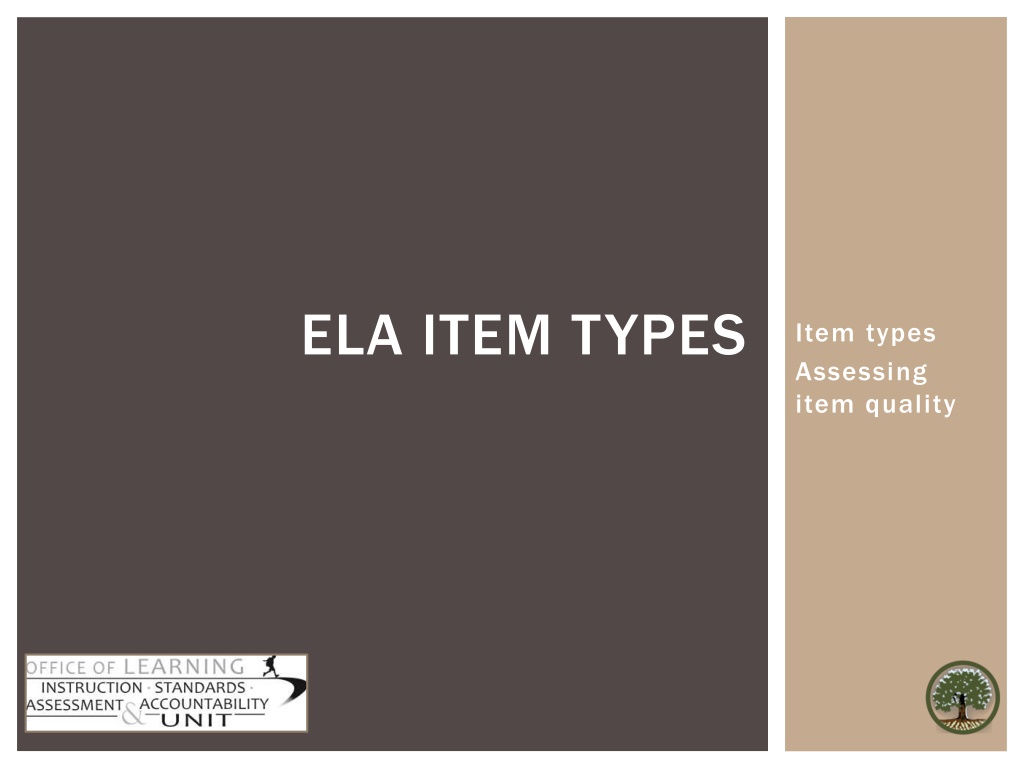
 undefined
undefined















